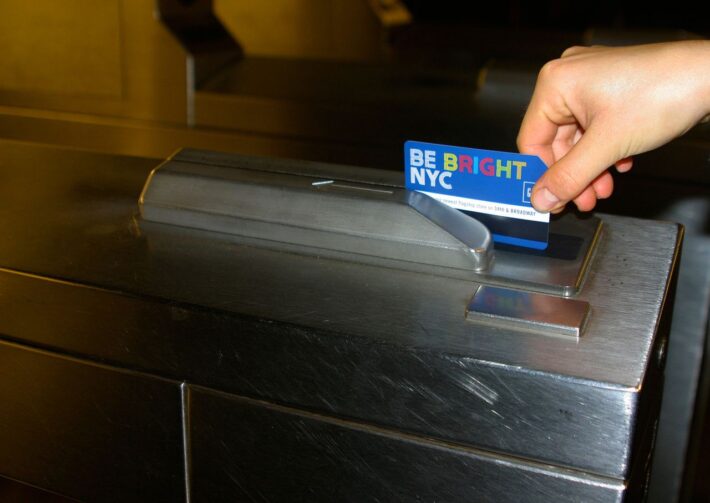
When Jennifer Meehan, a 31-year-old tourist from Ireland, first saw the Metropolitan Transit Authority’s new MetroCard, she didn’t realize what it was.
“It kind of looks like a discount card or something like that,” said Meehan. “I think it should say ‘Metro’ on it.”
Instead of the classic yellow background with blue lettering that spells out “MetroCard”—familiar to locals and tourists alike—the card is navy blue and reads “Be Bright NYC” in large block letters. There is a small logo on the front for Gap, the American clothing chain, and a plug to shop at their new flagship store on the corner of West 34th Street and Broadway. There is a black magnetic strip, but no indication of which direction to swipe it. The back offers a 20 percent discount at any Gap store through Nov. 18.
The new MetroCards are the first in a slew of commercial ads that will be introduced by the MTA later this fall as part of their new self-managed MetroCard advertising initiative to boost revenue. Gap purchased one million ads—for an undisclosed sum—from the MTA to gain publicity and promote the opening of their newly renovated flagship. The MTA has sold ad space on the back of MetroCards since 1995, but the new cards mark the first time an ad has ever appeared on the front.
The cards are sold at 10 Manhattan subway stations, handpicked by Gap based on their closeness to the flagship location and their high volume of commuter traffic. All of the stations serve two or more subway lines, and approximately 10 percent of the MetroCards sold at the stations will feature the new ads.
When the MTA announced in July that it would begin to sell commercial advertising space on the front of MetroCards, Chris Gayton, the 45-year-old senior director of media and brand engagement for Gap, decided that this would be the perfect opportunity to support the opening of Gap’s new flagship store, so he reached out to the MTA for more information. After that, it was a matter of which company could submit the artwork for the advertisement first and get it approved.
“We were flooded with calls,” said MTA spokesman Aaron Donovan, 36. “Gap happened to be the first one to come around and finish the deal.”
According to Gayton, Gap’s New York flagship will feature digital screens, interactivity and an overall more modern presentation of the brand. The storefront is see-through, so passersby can observe the activity inside the store.
At the Oct. 10 opening, customers gave the new MetroCards mixed reviews. Paul Souffrant, a 26-year-old from Brooklyn, supports the change because he thinks the new cards could help prevent future fare hikes.
“I think it’s actually pretty positive and pretty beneficial to students or anyone in general being that the prices keep going up,” said Souffrant. “And the Gap has a good selection so 20 percent off can come in pretty handy.”
Others found the card’s lack of arrows indicating which direction to swipe to be puzzling. “It’s a little confusing if you’re not from here,” said Yami Emmanuel, 26, of Crown Heights, Brooklyn. “I wouldn’t even know which way to put it in.”
She added, “I like the MetroCard logo on the front. If that doesn’t say New York, I don’t know what does.”
Much to the dismay of many New Yorkers, the new advertisements will not have an effect on the subway fare hike, which is scheduled to occur in March. According to Donovan, the amount of money that the MTA needs to raise could be as high as $450 million per year.
“That money [from the new MetroCards] will not be anything close to something that would help us reduce the need for a fare increase,” said Donovan.
Next month, the MTA will hold a series of eight public hearings around New York City to take public input so that the MTA Board can make amendments, such as changes to the base fare or changes to the unlimited card. As far as the appearance of the card, Donovan said that the MTA is currently monitoring the way the public is accepting it and will evaluate whether or not the card is accessible.
“If there’s too much confusion or too much potential for confusion we can certainly be willing to revisit the standards and the guidelines,” said Donovan. “It’s an evolving program and we’re willing to make changes at need.”